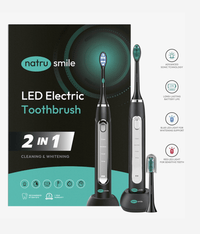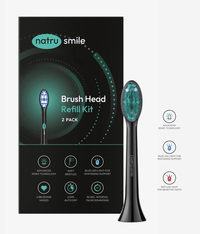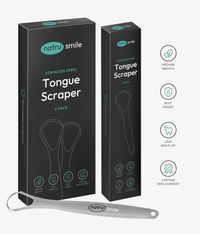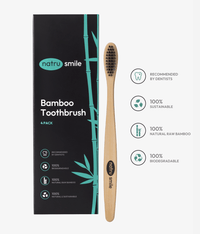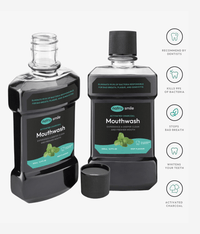
All products are certified by dental expert Dr. Greg Grillo
Tooth decay is one of the most common dental problems. One in four adults have had at least one cavity, meaning their tooth decay has progressed to the point where a filling is needed.
Fillings are used to restore these decayed teeth and help prevent further damage or decay. Since filling the affected tooth is the standard approach for cavity treatment, fillings are also one of the most common dental procedures.
If you have a cavity, understanding what to expect will help you financially and physically prepare for the procedure. This article dives into everything you need to know about tooth fillings, how much they cost, and what to expect from treatment.
What Are Dental Fillings? A Quick Look
Dental fillings are a type of restorative procedure used to repair damaged or decayed teeth. The filling material, usually either metal or composite resin, is inserted into the cavity to fill it and return the tooth to its normal shape and form.
Sometimes, fillings are also used for cosmetic purposes. For instance, if you have a chipped tooth or discoloration, the filling material can be used to improve the aesthetic of your smile.
Fillings are used for both aesthetic and functional purposes, as they restore the look and feel of the tooth and protect it from further damage or decay.
Types Of Tooth Filling Material
When it comes to tooth fillings, there are several materials to choose from, each with its own set of advantages and disadvantages.
Here are the most well-known types of tooth-filling materials:
Gold
Gold is one of the oldest filling materials available, and it is rarely used in modern dental practice. While gold fillings can be expensive, they are highly resistant to wear and tear and can last up to 20 years or more with proper care.
One of the main reasons gold fillings are uncommon is that they are difficult to customize and require multiple appointments for the fitting process. Since the gold color stands out against a regular tooth, they also don't work for front teeth or other visible areas.
Porcelain
Porcelain fillings—also known as inlays or onlays—are made from a type of ceramic material that is highly resistant to stains and can be color-matched to your natural teeth. They are an excellent option for filling larger cavities, lasting up to 15 years or more.
Porcelain fillings are some of the most common, and they are more aesthetically pleasing than other options since they can be customized to match your tooth color. The only downside is that porcelain fillings can be costly, making them less affordable for some patients.
Silver Amalgam
Silver amalgam fillings have been used for over a century and are a popular option for filling cavities in molars and premolars. They are made from a mixture of metals, including silver, tin, copper, and mercury, which can raise concerns about mercury toxicity for some patients. Despite these concerns, silver amalgam fillings are safe, highly durable, and still commonplace in some dental practices for their low cost.
Just like gold fillings, silver amalgam is visible and cannot be used for front teeth. Since silver contrasts with the whiteness of teeth, many patients don't even like them for their back teeth—opening the oral cavity reveals an unattractive silver filling.
Composite Resin
Composite resin fillings are made from a tooth-colored mixture of plastic and glass materials. They are a popular option for filling cavities in visible teeth as they can be color-matched to your natural teeth.
While composite resin fillings are not as durable as gold or porcelain fillings, they are still a long-lasting option that can last up to 10 years or more. The main advantage of composite resin fillings is that they are more attractive and aesthetically pleasing than silver amalgam fillings. They come at higher costs, though, making silver amalgam a more feasible option for some patients.
Ceramics
Ceramic fillings are similar to porcelain fillings, but they are made from different types of ceramic material, including leucite, lithium disilicate, and aluminum oxide. They are strong, color-matched to your teeth, and stain-resistant—perfect for filling cavities in visible areas. They are highly resistant to stains and can be color-matched to your natural teeth. Ceramic fillings are a great option for filling larger cavities and can last up to 15 years or more.
Glass Ionomer
By blending acrylic and glass materials, glass ionomer fillings provide a viable, short-term solution for cavities. They are a popular option for filling cavities in young children as they release fluoride, which can help prevent further tooth decay.
Glass ionomers work by bonding to the dentin and the enamel of the tooth, which makes them less likely to come loose or fall out. They are not as durable as other filling materials, making them best for temporary dental fillings. Still, they can last up to five years with proper care and maintenance.
Which Type Of Tooth Filling Is Best?
Deciding which type of tooth filling is best depends on several factors, such as the size and location of the cavity, the patient's dental history, and their personal preferences.
While metal amalgam fillings are often the cheapest option, they are not the best choice by any means. Composite and porcelain fillings are the best options, and they each offer their own unique benefits.
Composite fillings are more aesthetically pleasing and can be colored to match the natural tooth color. They are relatively inexpensive and easy to administer, meaning patients won't need to wait long to get their cavities filled. Composite fillings are also a good choice for smaller cavities and can be less invasive than other filling options.
Porcelain fillings are more costly but offer more durability. Like composite fillings, they mimic the natural tooth color, making them an ideal choice for visible teeth. They're perfect for larger cavities and severe tooth decay, since they cover more surface area.
Ultimately, the best type of tooth filling will depend on your individual needs and preferences. Your dentist can help you determine which filling material is best for your specific case, taking into consideration factors such as the location and size of the cavity, your budget, and your long-term dental health goals.
Dental Filling Procedure: Step-By-Step
Your exact procedure will vary based on the severity of your cavity and the type of filling your dentist recommends. More severe cases require thorough tooth preparation, while smaller cavities may require only minor adjustments.
Here are the general steps involved in getting a cavity filled:
Step 1: Numbing The Area
The first step of the dental filling process involves numbing the area around the affected tooth to ensure that you do not feel any pain or discomfort during the procedure. Your dentist will typically use a local anesthetic—a medication that is applied directly to the area of your mouth where the filling will be placed.
Your dentist may apply the anesthetic using a small needle or by using a numbing gel or spray. You may feel a slight pinch or pressure as the anesthetic is injected, but you shouldn't feel any pain.
Once the anesthetic takes effect, you won't be able to feel anything in the area around the tooth that is being filled.
Step 2: Removing The Decay
Next, your dentist will use a dental drill or laser to remove the decayed part of the tooth. They will then clean out the cavity to prepare it for the filling material. This is critical to ensuring the filling is stable, durable, and long-lasting.
After the cavity is cleaned, they will prepare the cavity for the filling material. This may involve etching the tooth surface with an acid solution to create a rough surface that will help the filling material bond to the tooth. They may also apply a bonding agent to the tooth surface to help the filling material adhere properly.
Step 3: Placing The Filling
Your dentist will select the appropriate filling material for your tooth and carefully place it in the cavity, building up the material in layers to create a strong, stable filling.
As the filling material is placed, your dentist will carefully shape it to fit the contours of your tooth and bite. To do this, they will use special tools to sculpt the filling material and ensure that it fits properly and does not interfere with your natural bite.
Once the filling material is in place, they will check for interference with your bite and comfortability in your mouth. They will ask you to bite down on a special paper that will indicate whether or not additional work is needed.
Once application is complete, they will use a special light to cure or harden each layer of filling material, ensuring that it adheres properly to the tooth.
Step 4: Polishing And Finishing
Once the filling material is in place, your dentist will polish it to smooth out any rough edges and make it look and feel like a natural tooth. They will continue to check your bite and make adjustments as needed.
At the end of the procedure, they'll apply a fluoride gel or varnish that strengthens your tooth and prevents further decay.
Step 5: Aftercare
After the procedure, your dentist will give you instructions on how to care for your new tooth and what to expect regarding pain from your dental filling.
Aftercare is fairly simple—you should brush and floss your teeth normally, but be careful not to damage the filling. It's also important to avoid food and beverages that are especially hot or cold as this can cause pain or discomfort in the area of your new filling.
How Should I Care For My Teeth With Fillings?
If you want your tooth filling to last as long as possible, you'll need to make sure you take proper care of it. The good news is, this isn't difficult—once your tooth is filled, you should brush and floss it just like you would any other tooth.
Follow these tips to maximize the longevity of your dental fillings:
- Keep up with your oral health routine. Twice daily brushing with a soft-bristled brush and fluoride toothpaste, followed by once-daily flossing is essential to preventing decay. Regularly removing plaque and food particles from your teeth helps keep them strong and healthy.
- Stick to your routine dental check-ups. Make sure to schedule regular checkup appointments with your dentist. This will allow them to monitor the condition of your fillings and make any necessary adjustments or repairs. It can also help you catch early signs of infection underneath the filling.
- Avoid sugary foods and drinks. Foods and drinks that damage your teeth (e.g., sugary snacks and drinks) can also damage your fillings. To protect your fillings and the area around them, try to limit your intake of sugary foods and drinks.
- Be careful with hard foods. Hard foods like ice, candies, and popcorn kernels can chip or crack a filling, so it's important to be cautious when eating them. If you're going to eat something hard, cut it into small pieces that you can easily chew and swallow.
- Know the signs of infection. Learn how to recognize the signs of infection, such as pain and sensitivity in the area around your filling. If you notice any signs of infection, contact your dentist right away.
- Avoid teeth grinding. If you grind your teeth at night, talk to your dentist about getting a mouthguard to protect your teeth and fillings from erosion.
How Long Does A Dental Filling Take?
In general, a dental filling should only take somewhere between thirty minutes and an hour. Even if the cavity was large or there were several cavities that needed to be filled, your dentist should still be able to complete the procedure within an hour.
That said, the exact length of time it takes for a dental filling will depend on how deep and complicated the cavity is and what kind of materials are used in the filling. If you're getting a more complex filling, it may take longer—up to two hours.
Understanding The Costs Of Dental Fillings
Like all dental procedures, the cost of a filling varies based on the materials used and how complex the procedure is. The cost also varies from dentist to dentist, as some charge more than others—particularly in areas with high living costs.
Without Insurance:
Without insurance, the cost of a dental filling can range from approximately $200 to $600 per tooth, depending on the factors mentioned above. The cost of fillings made of less expensive materials, such as amalgam or composite resin, may be lower than the cost of more expensive materials, such as porcelain or gold.
With Insurance:
With insurance, the cost of a dental filling can vary depending on the specifics of your plan but is usually much cheaper. Some dental insurance plans cover the full cost of certain types of fillings, while others may cover only a portion of the cost.
In some cases, dental offices may offer payment plans or financing options to help make the cost of dental fillings more manageable.
How Long Can Dental Fillings Last?
Here are some general guidelines for how long different types of fillings may last:
- Amalgam fillings: Amalgam fillings are made of a combination of metals and are known for their durability. They can last up to 10 to 15 years or longer with proper care.
- Composite fillings: Composite fillings are made of a tooth-colored resin material and are less durable than amalgam fillings. They can last up to 5 to 7 years or longer with proper care.
- Porcelain fillings: Porcelain fillings are highly durable and can last up to 15 years or longer with proper care. They are more expensive than other filling materials, but they can provide a long-lasting and natural-looking restoration.
The lifespan of a filling can be affected by several factors, including your oral hygiene habits, the amount of wear and tear on your teeth, and the presence of other dental issues such as gum disease. Movement in your mouth or changes to your gumline from orthodontic relapse can also cause your bite to change and your fillings to fall out.
Regular dental check-ups and cleanings can help to monitor the condition of your fillings and ensure that they are still in good condition.
Want to learn more? These are the questions our customers ask us the most.
How Does A Dental Filling Work?
A dental filling is a restorative procedure used to repair teeth affected by decay, fractures, or wear. It involves removing the damaged portion of the tooth, cleaning the area, and filling it with a suitable material, such as composite resin, amalgam, or porcelain. The filling restores the tooth's shape, function, and structural integrity, while preventing further decay or damage.
Is Dental Filling Permanent?
Dental fillings are considered semi-permanent, as they can last for many years, but may eventually need to be replaced. The lifespan of a filling depends on various factors, such as the material used, the size and location of the filling, and the patient's oral hygiene habits. Composite resin fillings typically last 5-10 years, while amalgam fillings can last 10-15 years or longer.
Can Fillings Damage Teeth?
When done correctly by a dental professional, fillings should not damage teeth. However, certain issues may arise, such as tooth sensitivity, discomfort, or an improperly sealed filling. In rare cases, the filling may not bond well to the tooth, resulting in bacterial infiltration and further decay. Regular dental checkups can help identify and resolve these issues.
What Are The Disadvantages Of Tooth Filling?
Some disadvantages of tooth fillings include:
- Tooth sensitivity: Following a filling, the treated tooth may experience sensitivity to heat, cold, or pressure.
- Material limitations: Some filling materials may be less durable or not match the tooth's natural appearance.
- Replacement: Fillings may need to be replaced over time due to wear or damage.
- Cost: The cost of fillings can vary based on the material and the complexity of the procedure.
Can I Brush My Teeth After A Dental Filling?
Yes, you can brush your teeth after a dental filling. However, it's essential to be gentle around the treated area, especially within the first 24 hours. Using a soft-bristled toothbrush and non-abrasive toothpaste can help protect the new filling and the surrounding tooth structure.
What Should You Avoid After Fillings?
After receiving a dental filling, you should avoid:
- Chewing on the treated side or area. Unless the anesthesia has worn off, you may inadvertently bite your cheek or tongue.
- Consuming hot or cold foods. Your tooth may be sensitive to temperature changes.
- Eating hard or sticky foods. They can cause your new filling to come loose or get pulled off your tooth.
- Smoking or using tobacco products. Smoking can damage your filling and cause severe harm to your oral health.
- Clenching or grinding teeth: This can put undue pressure on the filling, leading to potential damage.
How Many Times Can A Filling Be Replaced?
A filling can be replaced as many times as necessary, provided there is sufficient healthy tooth structure remaining to support the new filling. However, each time it is replaced, more of the tooth's structure is removed, which can weaken the tooth over time. In some cases, when a tooth has been filled multiple times, a dental crown or other restorative options may be recommended to protect the remaining tooth structure.
What Should I Not Do Before A Tooth Filling?
Prior to a tooth filling, refrain from:
- Consuming excessive caffeine: This can increase anxiety and make it difficult to relax during the procedure.
- Eating a large meal: Opt for a light meal to avoid feeling too full or uncomfortable in the dental chair.
- Using tobacco products: These can negatively impact oral health and the effectiveness of the filling.
- Neglecting oral hygiene: Maintain your regular brushing and flossing routine to keep the treatment area clean.
What Can Damage Fillings?
Factors that may harm fillings include:
- Hard or crunchy foods: They can cause undue stress on fillings, leading to fractures or dislodgment.
- Sticky foods: These may pull at the filling, potentially weakening its bond to the tooth.
- Teeth grinding or clenching: Habitual grinding can result in excessive pressure on fillings, causing cracks or wear.
- Poor oral hygiene: Neglecting dental care can contribute to bacterial buildup, which can compromise the filling's effectiveness.
Do Fillings Feel Weird At First?
It's normal for a new filling to feel slightly strange, as your mouth adjusts to the altered tooth shape and texture. Sensitivity to temperature or pressure may also occur. These sensations typically subside within a few days to weeks.
Can I Go To Work After A Filling?
Yes, most people can resume work or other daily activities immediately after a filling. However, be mindful of the numbness from local anesthesia, which may take a few hours to wear off. Avoid eating or drinking until the numbness subsides to prevent accidental injury.
How Long Does It Take To Fill Three Cavities?
The time required to fill three cavities depends on their size, location, and complexity. On average, each filling takes about 30 minutes to an hour. For three cavities, this means you can expect the procedure to last between 1.5 to 3 hours.
How Should I Prepare For My First Filling?
To prepare for your initial filling:
- Discuss any concerns with your dentist. Address questions about the procedure, materials, and aftercare.
- Plan ahead with your work or school schedule. Consider taking the day off or planning an extended period of time off in the middle of the day (at leas a few hours).
- Prepare financially. Ask your dentist about your insurance coverage, available payment options, and estimated costs. Talk with your insurance company about your benefits.
- Practice relaxation techniques. Consider listening to calming music, reading a book, or taking deep breaths to reduce anxiety during the procedure.
- Stay hydrated and nourished. Eat a light meal an hour prior to your appointment and bring snacks for afterward if necessary. Drink water before and after the filling as well.
How Long Does The Numbing Last After A Filling?
Local anesthesia's numbing effect typically lasts 2 to 4 hours after a filling. Be cautious when eating or drinking since your mouth will remain numb during this time. It's also important to avoid touching hot or sharp objects as you may experience accidental injury without realizing it.
How Many Fillings Are Typical For A Patient With Cavities?
The majority of people have at least one cavity, but the number of fillings required for any given patient varies depending on their oral health, dental hygiene habits, and the extent of tooth decay. Some patients may need just one filling, while others require multiple fillings for different teeth.
What Is The Cheapest Tooth Filling Option?
Silver amalgam fillings, made from a mixture of metals, are typically the most affordable dental filling option. While not as aesthetically pleasing as tooth-colored composite fillings, amalgam fillings are durable and cost-effective. However, prices may vary based on location, dental provider, and the complexity of the procedure.
Do You Need An X-Ray To Fill A Cavity?
An x-ray is not always necessary before filling a cavity, but it can be helpful in certain situations. X-rays can reveal the extent of tooth decay, particularly in areas that are not easily visible to the naked eye. They can also help dentists identify any underlying issues that may impact the treatment plan. Your dentist will determine if an x-ray is needed based on your individual case and oral health history.
Can I Fill A Cavity At Home?
Filling a cavity at home is not recommended, as it requires professional dental expertise, equipment, and materials. Attempting to fill a cavity on your own may lead to inadequate treatment, further tooth damage, injury to the surrounding area, or infection.
Can Cavities Come Back After Filling?
Cavities can potentially recur around or under a filling if oral hygiene is neglected or if the filling becomes damaged, cracked, or worn. Bacteria can infiltrate the space between the filling and the tooth, leading to new decay. Regular dental checkups can help detect and address such issues early on, minimizing the risk of recurrent cavities.
Do I Need A Root Canal Or A Filling?
The choice between a root canal and a filling depends on the extent of tooth decay and the health of the tooth's pulp. If the decay is limited to the outer layers of the tooth (enamel and dentin), a filling is typically sufficient. If the decay has reached the tooth's inner pulp, causing inflammation or infection, a root canal may be necessary to remove the damaged pulp, clean the tooth's interior, and seal it with a filling or crown.
Can A Cavity Go Away With Brushing?
Brushing alone cannot reverse a cavity, as tooth decay results from the destruction of tooth structure by acids produced by bacteria. Once the decay process has begun, it cannot be reversed by simply brushing. However, maintaining good oral hygiene through regular brushing, flossing, and dental checkups can help prevent further decay and catch existing cavities early, before they require more invasive treatment.
Do Tooth Fillings Need Crowns?
Fillings do not always require crowns, but in some cases, a dental crown may be recommended to protect and strengthen the tooth. If a tooth has been extensively damaged by decay or has a large filling that compromises its structural integrity, a crown can provide added support and durability.
How Do I Know If I Need A Filling?
Signs that you may need a filling include:
- Increased sensitivity to hot, cold, or sweet foods and beverages, or a persistent toothache without any aggravation.
- Visible decay or damage on the tooth's surface.
- A change in the tooth's texture may indicate a fractured filling or the beginning of decay.
- Food frequently becomes lodged between or within teeth, suggesting a possible cavity.
Is It Possible To Avoid Dental Fillings?
While it's not always possible to avoid fillings entirely, maintaining good oral hygiene and adopting preventive measures can significantly reduce the risk of developing cavities that require fillings. To minimize your risk:
- Brush your teeth twice a day with fluoride toothpaste.
- Floss daily to remove plaque and food debris between teeth.
- Visit your dentist regularly for checkups and cleanings.
- Limit sugary and acidic foods and drinks.
- Consider dental sealants or fluoride treatments for added protection.
Can A Filling Turn Into A Root Canal?
In some cases, a tooth with a filling may eventually require a root canal if the decay progresses to the tooth's pulp or if the tooth becomes cracked or damaged, allowing bacteria to enter the pulp chamber. Regular dental checkups can help monitor the health of filled teeth and address issues early on to minimize the risk of needing a root canal.
Does Salt Water Help After Filling?
Rinsing with warm salt water after a filling can be beneficial, as it helps clean the oral cavity and soothe any mild irritation or inflammation around the treated area. However, avoid vigorous swishing or rinsing during the first 24 hours after the procedure to prevent dislodging the filling. It's also essential to follow your dentist's specific aftercare instructions for the best results.
How Many Fillings Can I Get In One Visit?
The number of fillings that can be completed in one visit depends on factors such as the size and location of the cavities, the patient's comfort level, and the dentist's schedule. In some cases, multiple small fillings can be done in a single appointment, while more extensive or complex cases may require multiple visits. Your dentist will discuss the most appropriate treatment plan based on your individual needs.


